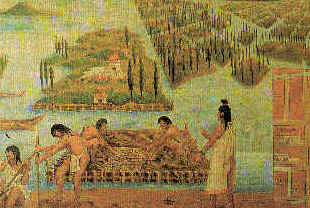

Aztec Life
![]() Home
Home
When the city of Tenochtitlan grew to the point where there was no more room for expansion on the island, the people were forced to move out onto the lake areas. This was when the chinampas or 'floating gardens' were invented. The chinampas especially helped the agricultural expansion. The chinampas were constructed by bunching twigs together and then stacking mud on top of the twigs. They were not anchored at first and could be towed until the plants roots anchored into the lake floor. Chinampas were very busy places. Turkeys were kept in small gardens with a hut to go into at night. Dogs ran around freely. When the dogs were fully grown they were often killed and eaten. The women grew flowers on the chinampa and sold them in the market. The men grew the corn. When the corn was ripe, it was put into corn bins and taken to the market or eaten later in the year.

Aztec women wore a skirt wrapped around their hips and waist. Men wore loincloths, often wearing a sleeveless poncho or cloak over it. All men carried a small pouch under their cloak or poncho that was slung over their shoulder. They used it to carry cocoa leaves to chew which were like tobacco leaves. Tropical birds were hunted and kept in captivity for their feathers. The feathers were plucked and then woven into beautiful designs or they were used for head dresses. The tradition of weaving and spinning was pracitced by all women. They were expected to weave for thier families' needs and to contribute woven goods as payment and taxes to the rulers.
The Aztecs did not use letters to write with, they used small pictures called glyphs instead of words. They would join a few glyphs together to make a sentence. Sometimes they would tell a whole story in one complicated picture. An Aztec manuscript is not read but like a puzzle picture in which the glyphs provide clues as to what is going on. The lower part of the picture shows the ground, while the upper part is the sky. Distance is shown by placing the furthest figures at the top of the page and the nearest at the bottom. Importance is shown by size; a victorious king may be drawn larger than his defeatede enemy. Death was shown by a corpse wrapped for burial; night by a black sky and a closed eye and war by a shield and a club. Aztec names could usually be written in picture form too. The name of the Emperor Acamapichtli means 'Handful of Reeds' and the corresponding picture is of an arm with the hand grasping a bundle of stalks. Here are some examples of glyphs and what they stand for.

The Aztecs had no doctors or hospitals, so being ill was very serious. Medicines could be bought in the market form apothecaries. The apothecaries sold many different herbs. There was tobacco and copal which was burned to purify the house of a sick person; yello chillies, which were good for stomach upsets; cuiapatli, which helped women who were having babies; peyotl, which made you sleep. Ointments were rubbed on the skin. If they had a sore spot, it was rubbed with squashed black beetles; for sore throats, there was rubber and honey to rub on. Rubber was also good for painful ears and mouths.